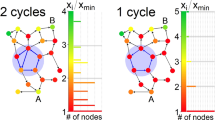Abstract
Studies are made of basic regularities of the process of switching over intermittency in the change of the trend of development of the cascade-hierarchical system. It is shown that the transition from the section of growth to the section of fall can be explained as a result of the change of the sign of the feedback (from the positive to the negative one) between the increment of the intermittency exponent Δµ and the increment of the fractal dimension Δd f (the expansion of the “channel” of attraction) for the most rapidly orienting (short-term) dynamic substructures. The subsequent break of the information-investment flow (the flow of commands) from the long-term to short-term substructures makes it impossible to support the dynamic equilibrium in the cascade-hierarchical system, which leads to the bifurcation transition to a new section of the channel of attraction.
Similar content being viewed by others
References
Temam, R., Infinite-dimensional Dynamical Systems in Mechanics and Physics, New York: Springer, 1988.
Krasovskii, A.A., From Cybernetics, Synergetics to the Principle of the Least Action of Controllable Self-Organizing Systems, in Sovremennye metody upravleniya mnogosvyaznymi dinamicheskimi systemami (Modern Methods of Control of Multiply Connected Dynamic Systems), Krasovskii, A.A., Ed., Moscow: Energoatomizdat, 2003.
Ghashghaie, S., Breymann, W., Peinke, J., et al., Turbulent Cascades in Foreign Exchange Markets, Nature, 1996, vol. 381, pp. 767–770.
Kleparskii, V.G., Multifractality and Self-Adjustment of the Channel of Attraction of the Stock Market, Avtom. Telemekh., 2001, no. 4, pp. 109–119.
Frish, U., Turbulentnost’. Nasledie A.N. Kolmogorova (Turbulence. The Legacy of A.N. Kolmogorov), Moscow: Fazis, 1998.
Nelkin, M., Universality and Scaling in Fully Developed Turbulence, Adv. Phys., 1994, vol. 43, no. 2, pp. 143–181.
Malinetskii, G.G. and Potapov, A.B., Sovremennye porblemy nelineinoi dinamiki (Modern Problems of Nonlinear Dynamics), Moscow: Editoral URSS, 2000.
Kleparskii, V.G., Self-Development of Short-Term Substructures of Cascade-Hierarchical Systems, in Cognitive Analysis and Control of Development of Situations, Moscow: Inst. Probl. Upravlen., 2004, pp. 151–157.
Ott, E. and Sommerer, J.C., Blowout Bifurcations: The Occurrence of Riddled Basins and On-Off Intermittency, Phys. Lett. A, 1994, vol. 188, pp. 39–47.
Kleparskii, V.G. and Efremov, V.A., Multifractality, Dissipation, and Stability of Mean-Term Trends in the Stock Market, Probl. Upravlen., 2004, no. 4, pp. 36–38.
Cross, M.C. and Hohenberg, P.S., Pattern Formation Outside of Equilibrium, Rev. Mod. Phys., 1993, vol. 65, no. 3, part II, pp. 851–112.
Feder, J., Fractals, New York: Plenum, 1988. Translated under the title Fraktaly, Moscow: Mir, 1991.
Author information
Authors and Affiliations
Additional information
Original Russian Text © V.G. Kleparskii, 2007, published in Avtomatika i Telemekhanika, 2007, No. 4, pp. 92–100.
Rights and permissions
About this article
Cite this article
Kleparskii, V.G. Break of information-investment flows in the process of switching over intermittency in the change of the trend of development of the dynamic system. Autom Remote Control 68, 657–664 (2007). https://doi.org/10.1134/S0005117907040091
Received:
Issue Date:
DOI: https://doi.org/10.1134/S0005117907040091




